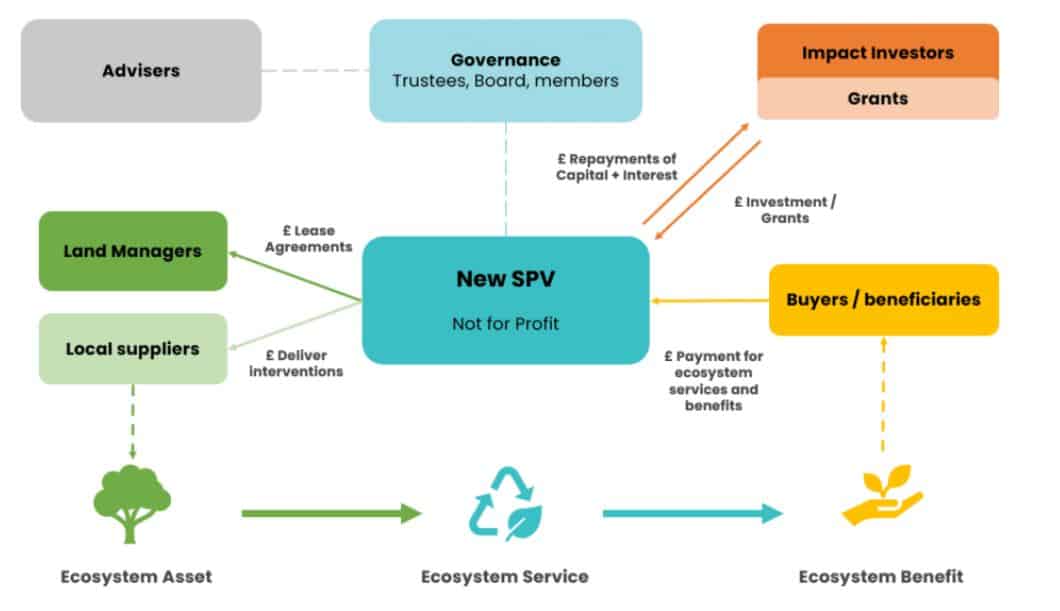Summary of the Wyre Catchment Natural Flood Management Project
The Wyre Catchment Natural Flood Management Project (Wyre NFM project) is the first example in the UK of farmers being paid to deliver natural flood management (NFM) as part of a commercial agreement. The project plans to deliver more than 1,000 targeted measures to store, slow and intercept flood water and prevent peak flow in a catchment in England. These interventions, such as leaky dams, hedgerows, ponds and scrapes, will be hosted by farmers for an annual hosting and maintenance fee over the next nine years, with an option to extend the project to up to 50 years. As of November 2023, the project has started to install these interventions on the lands of the farmers who initially signed up, and further farmers are being onboarded.
Farm Profile:
- Location: Lancashire
- Size of Farms: 5-1000 hectares
- Size of Land: 99 km2
- Tenancy & Ownership: Owner occupiers, tenant farmers
- Nature Market Focus: Natural Flood Management
- Interventions include: Leaky dams, woodland creation, ponds and scrapes, bunded hedgerows
- Project Partners: The Rivers Trust, The Wyre Rivers Trust, United Utilities, Environment Agency, Flood Re, Co-Op insurance, Triodos Bank, Esmée Fairbairn Foundation.
What do I need to know about nature markets to begin with?
This section of the Toolkit provides a brief overview of nature markets in England and how they relate to farmers. It is designed to answer some of the early questions that farmers may have around nature markets. All Toolkit content, including this Introductory section, will be updated regularly.
What market opportunities are available to me based on my land and goals?
This milestone will guide you through an initial assessment of your land as you determine what your broad vision is in relation to nature and help you to identify what opportunities might be available to you to attract private sector finance.
The actions taken at this stage can be taken before you’ve made the firm decision to engage in nature markets. The considerations presented in this milestone will help you determine whether nature market participation makes sense for your goals, the condition of your natural capital and your farming business.
You can also apply many of these considerations to develop a broader vision around your natural capital and other potential funding sources – such as government grant schemes or philanthropic funding.
Will I need to partner with other farmers, and if so, how?
Once you have a vision for your farm, the environmental enhancements or changes you want to make and a sense of the related income opportunities, you may want to consider joining up with other farmers in your area to implement your outcomes at scale to attract buyers.
Aggregation models, often started among farmer clusters or as farmer cooperatives, bring together multiple farmers or landowners to collectively participate in nature markets. These models aim to harness the combined efforts and resources of farmers to maximise environmental benefits and economic opportunities. This section will introduce the factors that may influence your decision to join up with other farmers and some of the key considerations to keep in mind when setting up and participating in such a group.
How do I measure the environmental outcomes that I can produce in a robust way?
At this stage you will have developed an overarching vision for your land and a rough plan for what you want to improve. You will now want to make robust baseline measurements of the condition of your land and develop a detailed plan for interventions and intended outcomes. Plans will also include how you intend to maintain your interventions, measure the impact you are having and verify your outcomes in order to sell them.
How should I identify and approach buyers for my outcomes?
During your initial project scoping, you may have identified potential buyers of the environmental outcomes you are planning to deliver. Now that you have a project plan and a robust baseline, you will be ready to approach and engage buyers more formally.
Buyers will vary in their expectations and requirements. This milestone will help you prepare for initial conversations with potential buyers to ensure you are empowered to ask the right questions and present a project that will attract a fair price. Your buyers may be within your own supply chain such as retailers and businesses, or organisations who benefit directly from your ecosystem services such as water companies or firms who seek to offset their own environmental impacts.
How would this project fit in with my current farming business model?
Nature market projects are often just one part of a farmer’s wider business. Some people compare building nature market projects to developing ‘micro businesses’ for the farm. As such, much of the content you see here will be familiar to you.
However, these projects also have key features that separate them from the businesses that farmers usually engage in. For example, the longer timeframes associated and the current uncertainties relating to how nature market projects (and the deals that result) can be blended with government schemes.
Below is a list of questions that will help you think through how to incorporate these projects into your current farm business plan. This includes considerations on building a cashflow or partial budget, but also the less quantifiable factors, such as the potential drawbacks and opportunities to your wider farm that nature markets present.
What kind of risks should I be aware of and how can I manage them?
Like with any aspect of a farm business, risk management is critical – especially for nature market projects that can run over several years. As the landholder, you may be leading the development of the project, be part of a wider group of farmers, or be working with a third-party project developer that is taking the majority of the risk.
In any case, it’s advisable to have a clear understanding of the likelihood of the risks involved, what will happen if the risk materialises, what you as the landholder might be liable for, and how the risk is being managed to prevent this liability.
This Milestone sets out the different types of risks that nature market projects (and the deals that result from them) often carry. The last section covers the types of legal entities that farmers might form, as these can help to manage certain risks and benefit the overall operations of the project.
Is it possible to use repayable finance upfront to meet any of the costs?
Repayable finance from investors – typically debt or equity – is not always necessary in nature markets if upfront costs can be met by the buyer or through grants.
It’s also important to note that, even when repayable finance is needed, farmers do not necessarily have to secure this themselves.
In the UK, there are very few examples of individual farmers taking out loans and no examples of farmers issuing shares to use specifically to finance a nature market project. Typically, the upfront capital required is organised by a third party – for example, a third-party project developer, a broker etc.
However, as nature markets develop further, and in the case of larger farms, there is potential for farmers to secure repayable finance and meet up-front costs, as with other parts of their business.
The below therefore sets out some questions that farmers (and, more likely, third party project developers) could ask themselves to secure repayable finance from lenders and investors, whether that’s taking on finance independently, or as part of a larger group or partnership.
What do I need to be aware of when signing contracts?
This Milestone is about the legal contracts you will use and sign to officially commit to the project and transition it to a fully fledged deal. As business owners, farmers are familiar with contracts and understand the need to carefully review the details before signing any such agreements.
Any nature market deal is likely to involve legal agreements that will be tailored to each set of circumstances. However, for ease this Milestone sets out what contract set-ups are used in this space, common contract types, and other key considerations to ask yourself at this stage.
Disclaimer: The information in this Milestone does not constitute any form of legal advice but instead serves as practical advice that has been written by speaking with lawyers, farmers and other practitioners. We recommend that appropriate legal advice should be taken from a qualified solicitor before taking or refraining from any action relating to your contracts and projects.
Can I participate on tenanted land?
The tenancy and ownership structure of land can have significant implications for farmers engaging in nature markets in the UK. The rights of tenants in relation to nature markets is still not entirely clear in the UK and may differ on a case by case basis. Below are some key considerations which can help both tenants and landlords in asking the right questions when considering engaging in nature markets as policy and legal frameworks develop. Further guidance prepared by the Tenant Farmers Association and the Country, Land and Business Association can be found here.
How do public sector funding and policy align with nature markets?
In England, the role of public funding and support to farmers is undergoing change on a scale not seen in decades. The government hopes to strengthen the link between environmental and farming practices to meet its climate and nature restoration targets, while maintaining food security and the viability of farm businesses across the country.
This section offers a summary of how government is working with farmers to access nature markets, and provides guidance on:
- How nature markets might work with public subsidy schemes,
- What development funding is available for farmers to explore their opportunities,
- What ‘market infrastructure’ the government is supporting – including Standards and Codes.
Groundwork
We have separated out these Milestones into ‘Groundwork’ and ‘Market Engagement’ to indicate which Milestones you will want to read as you consider and/or prepare for nature markets (Groundwork) and those you will move through if and when you decide to become a seller of environmental outcomes (Market Engagement).
We recommend all farmers read through the Groundwork Milestones in addition to the Introduction to Nature Markets in order to understand better whether nature markets are for them, and how they can, at the very least, explore and baseline their farms so they are ready for any opportunities that may arise later.
Market Engagement
We have separated out these Milestones into ‘Groundwork’ and ‘Market Engagement’ to indicate which Milestones you will want to read as you consider and/or prepare for nature markets (Groundwork) and those you will move through if and when you decide to become a seller of environmental outcomes (Market Engagement).
We recommend all farmers read through the Groundwork Milestones in addition to the Introduction to Nature Markets in order to understand better whether nature markets are for them, and how they can, at the very least, explore and baseline their farms so they are ready for any opportunities that may arise later.

